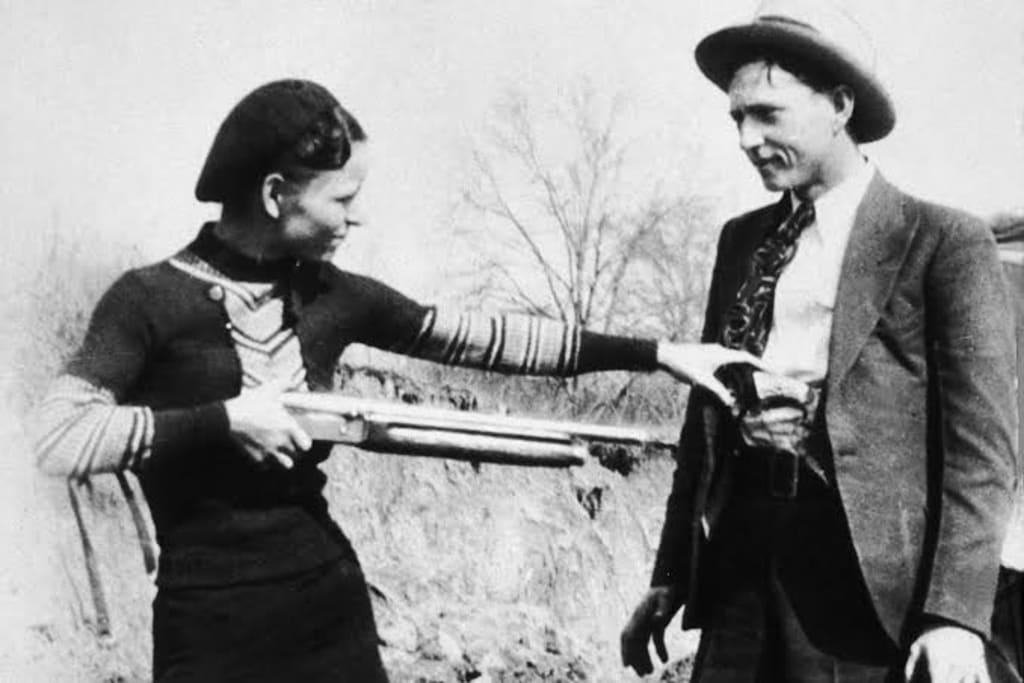Bonnie and Clyde: The Story of America’s Most Notorious Killer Couple
Partner in crime

The names Bonnie Parker and Clyde Barrow brings images of a romantic yet violent criminal partnership, a duo that has become synonymous with the outlaw culture of early 20th-century America. Their story, marked by a relentless crime spree during the Great Depression, is one of love, rebellion, and inevitable tragedy.
Early Lives and Meeting
Bonnie Elizabeth Parker was born on October 1, 1910, in Rowena, Texas. Her father died when she was young, and her mother moved the family to Dallas. Bonnie was a bright student with a passion for writing and poetry, but her life took a different turn when she dropped out of school and married Roy Thornton at 16. The marriage was short-lived, and Bonnie was left disillusioned and seeking excitement.
Clyde Chestnut Barrow, born on March 24, 1909, in Telico, Texas, came from a poor farming family. He turned to petty crime early in life, engaging in theft and other small-time criminal activities. Clyde's first arrest came in 1926 for failing to return a rental car, marking the beginning of his frequent encounters with the law.
The fateful meeting between Bonnie and Clyde occurred in January 1930. It is widely believed that they met at the home of a mutual friend. Clyde, already a fugitive, was captivated by Bonnie's charm, and the two quickly fell in love. This meeting set the stage for a partnership that would become one of the most infamous in American history.
The Crime Spree
Bonnie and Clyde's criminal activities escalated rapidly. After Clyde was released from prison in 1932, having experienced brutal conditions that further hardened him, he and Bonnie embarked on a series of robberies across several states, targeting small businesses, gas stations, and banks. They were joined by various accomplices, including Clyde's brother Buck and his wife, Blanche.
The Barrow Gang, as they became known, quickly gained notoriety for their daring heists and violent confrontations with law enforcement. Their robberies were marked by a mix of meticulous planning and reckless abandon. Clyde's driving skills and knowledge of backroads allowed them to elude capture multiple times.
Their exploits were not without bloodshed. They killed multiple law enforcement officers and civilians who stood in their way. These violent encounters only increased the public and police's determination to capture them. Despite their criminal activities, Bonnie and Clyde became folk heroes to some, seen as rebels fighting against the oppressive conditions of the Great Depression.
The Famous Photos
In March 1933, police raided an apartment in Joplin, Missouri, where the gang was hiding out. Although the gang escaped, they left behind a roll of film containing now-iconic photographs. These images, showing Bonnie and Clyde posing with guns and cigars, helped cement their place in the public imagination. The photographs portrayed a glamorous, carefree couple, despite the deadly reality of their lives.
The Downfall
The relentless pursuit by law enforcement eventually took its toll. In January 1934, Clyde orchestrated a daring raid on the Eastham prison farm, freeing several inmates and killing a guard. This act intensified the manhunt for the couple. The turning point came when a Texas Ranger named Frank Hamer was brought out of retirement to track them down.
Hamer and his posse methodically tracked the movements of Bonnie and Clyde. On May 23, 1934, they set up an ambush on a rural road in Bienville Parish, Louisiana. As Bonnie and Clyde drove down the road, the posse opened fire, killing the couple in a hail of bullets. Their bodies were so riddled with bullets that identification was almost impossible.
Legacy
The story of Bonnie and Clyde has been romanticized in popular culture, from songs and books to the 1967 film starring Warren Beatty and Faye Dunaway. Their legacy is a complex one, blending myth and reality. They are remembered both as ruthless criminals and as tragic figures of a desperate era.
In examining their story, one cannot ignore the socio-economic context of the Great Depression, which shaped their lives and actions. They emerged as symbols of defiance against a system that many felt had failed them, embodying the desperation and disillusionment of their time.
Bonnie and Clyde's tale is a reminder of the thin line between fame and infamy, and how the harsh realities of life can lead individuals down dark and dangerous paths. Their love and partnership, however, remain at the heart of their story, adding a layer of human complexity to their notorious legacy.
About the Creator
Enjoyed the story? Support the Creator.
Subscribe for free to receive all their stories in your feed. You could also pledge your support or give them a one-off tip, letting them know you appreciate their work.






Comments
There are no comments for this story
Be the first to respond and start the conversation.